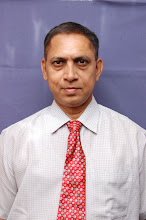To change one’s own self first is a difficult
task but that is how we can effect a change around us. By expecting others to
change themselves without taking any step to change oneself will result in
dissatisfaction and unhappiness.
For making a change, you have to act in this
world. Think of the reality (Brahman) and do whatever you want to do. Change
comes when you move from self-centeredness (inability to accommodate anything
beyond your own interests) to unselfishness and then finally to selflessness.
The formula of success is to move from selfish desires to unselfish desires to
selfless desires. By your own acts, make your home become a centre for
happiness. Then the world will compliment you.
You are the architect of your fortunes. You are the architect of your
misfortunes. Eradicate your Vasanas (Unfulfilled Desires) so that mind and
intellect is absorbed in the truth. Then you merge with the reality. If you are
determined to be healthy, your mind will think about being healthy. Mind and
intellect get absorbed in this reality and you merge with the truth. We could
be called “Brahman - proof”. Brahman is a word for God. Brahman is Allah in
Islam and Jesus in Christianity. God is beyond human conception. He has no
birth and death. You cannot perceive god. You can only become God.
Human – Desire = God.
You have got to use life to find the truth.
For this to happen, Change yourself not the world.
Tell yourself “I will change myself every day
in every way”. If told with Bhakti and devotion, you will find a change in
yourself and further notice the changes happening around you. Whatever happens
in life happens with a reason. God wanted to teach me a few lessons. I believe
in hard work and God. I know god is always with me and I think of him wherever
I go. “What is the difference between
school and Life? In school, you’re taught a lesson and then given a test. In
life, you’re given a test that teaches you a lesson”.
President John F. Kennedy in his inaugural
address in January 1961, mentioned to the fellow Americans, “Ask not what your
country can do for you – Ask what you can do for your country”. JFK told the
fellow citizens of the world, “Ask not what America will do for you, but what
together we can do to the freedom of man”.
Mahatma Gandhi said, “You must be the Change
you wish to see in the world”. We should remember; where there is Love there is
Life. Happiness is when what you think,
what you say, and what you do are in harmony. In order to bring about positive
change in the world we need not only engage with the outer world but also
engage with our inner world. If we want to see greater awareness in the world,
we have to cultivate awareness. If we want to see greater harmony and less strife,
we need to learn to become more adept at handling our emotions and learn to
respond to frustrations with more patience and kindness than we do at present.
Meditation helps us to recognize unhelpful
emotional patterns and to develop the mental freedom to choose responses that
are more helpful. Among the virtues that Lord Krishna mentioned to Arjuna, at the
foremost was, ‘Never hate anyone’. The
cultivation of love and kindness helps us to find alternative and more
compassionate responses. Meditation helps us to be the change we wish to see in
the world. The thought of Change comes from within. When you have understood
the benefits of Change, you have to do Nidhithyasanam and be an example for
others to follow.
We should know that nature cannot be changed
because what cannot be changed is nature. Wisdom or intelligence is preparing
the mind to accept the choiceless or helpless situations without any
resistance. Success is not conquering the whole world. Success is accepting
everything you get as a gift from God. By repeating to ourselves (meditation /
Nidhithyasanam) and repeating to our mind that I am willing to undergo the
choiceless situations, we get freedom from stress. Examples of choiceless
situations are old age, incurable disease, separation from someone etc. The
only one who can be changed by me is myself. Pray to the Bagawan, “O Lord; give
me the courage to change what can be changed i.e. myself. O lord give me the
serenity to understand the difference that others cannot be changed and that I
should only change myself”.
Begin with yourself and be the change agent. You
can set an example for others to follow. This positive approach will definitely
yield good results.
The following words are said to be written on
the tomb of an Anglican bishop in the crypts of Westminster abbey in London,
England.
“When I was young and free and my imagination
had no limits, I dreamed of changing the world. As I grew older and wiser, I
discovered the world would not change –
So I shortened my sights somewhat and decided
to change only my country, but it too seemed immovable.
As I grew into my twilight years, in one last
desperate attempt, I settled for changing only my family, those closest to me,
but alas, they would have none of it.
And now I realise as I lie on my death bed, If I had only changed myself first, then
by example I would have changed my family. From their inspiration and
encouragement, I would then have been able to better my country,
And who knows, I might have even changed the
world”.
Let us be the factor of change. Change yourself
first, and see the change in the world around you thereafter. Start with
yourself and you can find your life peaceful and joyful. It is difficult to
change but not impossible. Every human being can make a life for himself.
Be blissful
S.SEKAR
Contact: sekrajc@yahoo.com
